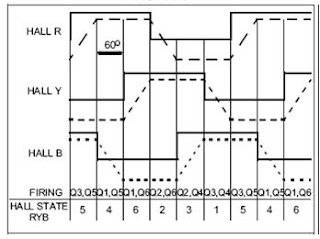Sensorless Brushless DC Motor Control with Z8 Encore! MC™ Microcontrollers
Abstract
This application note discusses the closed loop control of a 3-Phase Brushless
Direct Current (BLDC) motor using the Z8 Encore! MC™ Family of
Microcontrollers series microcontrollers (MCUs). The Z8 Encore! MC™ product
family is designed specifically for motor control applications, featuring an on-chip
integrated array of application-specific analog and digital modules. This in turn
results in fast and precise fault control, high system efficiency, and “on-the-fly”
speed / torque and direction control, as well as ease of firmware development for
customized applications.
This article further discusses ways on how to implement a sensorless feedback
control system using a “Phase Locked Loop” along with Back EMF sensing.
Sensorless control of 3-phase brushless DC motors
Introduction
This application note describes how to implement sensorless commutation control
microcontroller. A general solution, suitable for most 3-phase BLDC motors on the
market is presented. The full source code is written in the C language, no assembly
is required. Adaptation to different motors is done through the setting of parameters
in the source code.
The ATmega48/88/168 devices are all pin and source code compatible. The only
difference is memory sizes. This application note is written with ATmega48 in mind,
but any reference to ATmega48 in this document also applies to ATmega88/168.
Brushed DC motor control using the LPC2101 microcontroller
Introduction
This application note demonstrates the use of a low cost NXP Semiconductors LPC2101 microcontroller for bidirectional brushed DC motor control.
The LPC2101 is based on a 16/32-bit ARM7 CPU combined with embedded high-speed flash memory. A superior performance as well as their tiny size, low power consumption and a blend of on-chip peripherals make these devices ideal for a wide range of applications. Various 32-bit and 16-bit timers, 10-bit ADC and PWM features through output match on all timers, make them particularly suitable for industrial control.
Brushed DC (Direct Current) motors are most commonly used in easy to drive, variable speed and high start-up torque applications. They have become widespread and are available in all shapes and sizes from large-scale industrial models to small motors for light applications (such as 12 V DC motors).
Sensorless BLDC Motor Control Using MC9S08AC16
Introduction
This application note describes the design of a 3-phase
sensorless BLDC motor drive with Back-EMF
zero crossing. It is based on Freescale’s MC9S08AC16
that can be effectively used for motor-control
applications.
The concept of the application is that of a speed-closed
loop drive using Back-EMF zero crossing technique for
positional detection. It serves as an example of a
sensorless BLDC motor control system using
Freescale’s MCU and 3-Phase BLDC/PMSM
Low-Voltage Motor Control Drive. It also illustrates
the usage of general on-chip peripherals for
motor-control applications.
This application note includes a description of the
controller features, basic BLDC motor theory, system
design concept, hardware implementation, software
design including the FreeMaster software visualization
tool, application setup, and demo operation.
Sensorless Brushless DC Motor Control with PIC16 Microcontroller
INTRODUCTION
There is a lot of interest in using Brushless DC (BLDC)
motors. Among the many advantages to a BLDC motor
over a brushed DC motor, we can enumerate the
following:
• The absence of the mechanical commutator
allows higher speeds
• Brush performance limits the transient response
in the DC motor
• With the DC motor you have to add the voltage
drop in the brushes among motor losses
• Brush restrictions on reactance voltage of the
armature constrains the length of core reducing
the speed response and increasing the inertia for
a specific torque
• The source of heating in the BLDC motor is in the
stator, while in the
DC motor it is in the rotor,
therefore it is easier to dissipate heat in the BLDC
• Reduced audible and electromagnetic noise



















